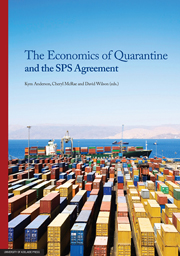Book contents
- Frontmatter
- Contents
- List of tables, figures and boxes
- Acronyms
- Preface
- List of contributors
- 1 Introduction
- PART I The multilateral rules under WTO
- PART II The ‘appropriate level of protection’
- PART III Adding more economics to risk analysis
- 11 Least trade-restrictive SPS policies: an analytic framework is there but questions remain
- 12 Quarantine decision making in Australia
- 13 Quarantine reform: Australia's recent experience
- 14 Evaluating economic consequences of livestock diseases: a US perspective
- PART IV Specific health and environmental risks from trade
- PART V Conclusion
- APPENDIX The legal text of the SPS Agreement
14 - Evaluating economic consequences of livestock diseases: a US perspective
from PART III - Adding more economics to risk analysis
Published online by Cambridge University Press: 05 June 2013
- Frontmatter
- Contents
- List of tables, figures and boxes
- Acronyms
- Preface
- List of contributors
- 1 Introduction
- PART I The multilateral rules under WTO
- PART II The ‘appropriate level of protection’
- PART III Adding more economics to risk analysis
- 11 Least trade-restrictive SPS policies: an analytic framework is there but questions remain
- 12 Quarantine decision making in Australia
- 13 Quarantine reform: Australia's recent experience
- 14 Evaluating economic consequences of livestock diseases: a US perspective
- PART IV Specific health and environmental risks from trade
- PART V Conclusion
- APPENDIX The legal text of the SPS Agreement
Summary
This chapter provides an overview of selected approaches to evaluating the economic consequences of livestock diseases. The presentation focuses on general types of analysis that may be needed, some examples of analytical tools, and discusses the linkages between some of the available tools. While the context of this discussion is primarily in the area of livestock diseases, these same concepts apply broadly and may be useful in the phytosanitary area as well.
Also discussed in the chapter is the international context for applying these analytical tools in terms of the World Trade Organization's Agreement on Sanitary and Phytosanitary Measures (the SPS Agreement) and the Office International des Epizooties (OIE) International Animal Health Code (OIE, 1999). In addition, the practicalities of consequence evaluation in regulatory environments are discussed as well as potential analysis trade-offs in the face of very limited resources.
Economic analysis is essential to understanding the risks of livestock diseases. As discussed in a recent workshop conducted by the US Department of Agriculture, “when decision-making is complex, economic analysis is often useful for putting probabilistic outcomes, which are the results of risk assessment, in perspective. For example, economics can translate the impacts of a disease outbreak termed ‘serious’ by veterinarians into economic losses to the livestock sector, which might then be compared to total livestock revenues. Thus, economic analysis can provide a basis for comparing different sources or types of risks.
- Type
- Chapter
- Information
- The Economics of Quarantine and the SPS Agreement , pp. 265 - 284Publisher: The University of Adelaide PressPrint publication year: 2012



